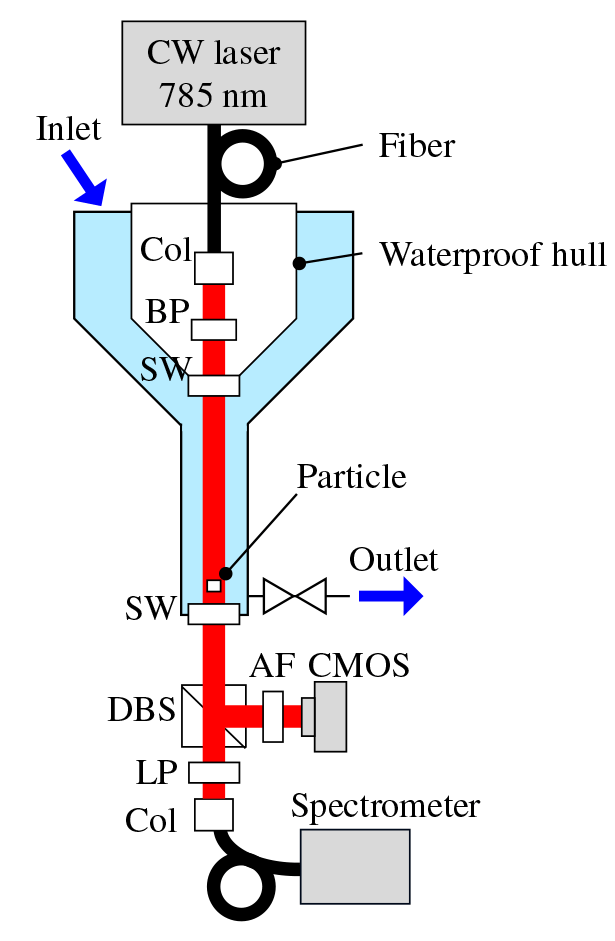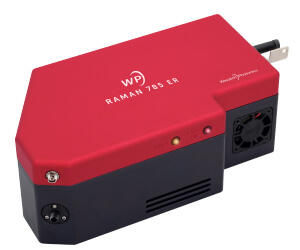Integrating Raman Spectroscopy & Holography for In-situ Detection of Microplastics
Microplastics in our ocean waters are a growing problem – but how do you collect quick and effective measurements in-situ, and at the depths needed to properly understand distribution, flow, and uptake by ocean life? Filtration-based methods using FTIR and Raman microscopy are well-proven, but work best for surface measurements where microplastic densities are higher. A collaboration of researchers from Japan and the UK are developing a compact, hybrid system using holography and Raman spectroscopy capable of in-situ monitoring of particle size, shape, and material – offering promise for monitoring at depths where sea life outnumbers the plastics.
Download the App NoteThe Plastics Problem Runs Deep
 Plastic pollution in the oceans is not confined to the surface, nor to discrete items like plastic bags or accumulations like the Pacific Garbage Patch. As these primary sources of plastic pollution break down, they create secondary pollution in the form of microplastics – particles below 5 mm in size – that can more easily be transported to all reaches and depths of the oceans. There, they can be ingested by all types of marine life, becoming part of a food chain upon which many species depend. In-situ monitoring data is needed to assess the extent, distribution, and changes in microplastic buildup in the ocean over time, particularly as a function of depth. This data will aid studies on the interaction of organisms and microplastics, and can be used to improve models of vertical transport. In future, it will help to guide remediation efforts, and gauge their effectiveness.
Plastic pollution in the oceans is not confined to the surface, nor to discrete items like plastic bags or accumulations like the Pacific Garbage Patch. As these primary sources of plastic pollution break down, they create secondary pollution in the form of microplastics – particles below 5 mm in size – that can more easily be transported to all reaches and depths of the oceans. There, they can be ingested by all types of marine life, becoming part of a food chain upon which many species depend. In-situ monitoring data is needed to assess the extent, distribution, and changes in microplastic buildup in the ocean over time, particularly as a function of depth. This data will aid studies on the interaction of organisms and microplastics, and can be used to improve models of vertical transport. In future, it will help to guide remediation efforts, and gauge their effectiveness.
Seeing Microplastics in Seawater

Many of the existing “collect & separate” methods for identification of microplastics are geared to sampling of surface waters, and require filtration to concentrate the sample sufficiently for detection. The spectra obtained via Raman spectroscopy is information-rich, but being a weak signal, is easier to obtain with a bulk sample. In deeper waters, the density of microplastics is far lower than at the surface, while the presence of native wildlife of similar dimensions can be rich. This poses two challenges for Raman-based detection: 1) achieving the needed signal, and 2) scanning sufficient volumes of seawater in the presence of unwanted background or ‘noise’.
To overcome this, a collaboration of researchers led by the Japan Agency for Marine-Earth Science and Technology (JAMSTEC), the University of Tokyo, the University of Southampton, and the University of Aberdeen are developing a compact but sensitive hybrid flow-through detection system capable of characterizing individual particles. It relies on digital holography to pre-screen particles of interest by size and shape to determine if they are likely to be man-made or natural. Raman spectroscopy can then be performed selectively, increasing the throughput of the system. This would allow continuous and efficient in-situ monitoring even at depths where microplastic particles are infrequent.
To test this concept, the team designed a dual-purpose system with a single 785 nm laser as illumination source for both imaging and Raman spectroscopy. After crossing the sample flow channel, a beam splitter directs part of the transmitted laser light to a fast CMOS camera for digital holographic imaging, leaving the rest for Raman spectroscopy. Transmission Raman is used routinely for pharmaceutical analysis, and so the team was keen to assess whether it could be used to detect microplastic particles in-situ without physical trapping on a membrane.
 A compact Wasatch Photonics WP 785 ER spectrometer is used for the material analysis, measuring a 200-3100 cm-1 range with 8 cm-1 resolution. A sensitive yet compact Raman spectrometer is essential to the design, as the same collimated 4 mm beam being used for digital holography is required to function as the illumination source for Raman, passing through a 20 cm flow channel prior to detection of scattered Raman signal.
A compact Wasatch Photonics WP 785 ER spectrometer is used for the material analysis, measuring a 200-3100 cm-1 range with 8 cm-1 resolution. A sensitive yet compact Raman spectrometer is essential to the design, as the same collimated 4 mm beam being used for digital holography is required to function as the illumination source for Raman, passing through a 20 cm flow channel prior to detection of scattered Raman signal.
The hybrid system was tested with a flow containing transparent pellets of polystyrene (PS) and PMMA 3 mm in size, capturing both digital images and Raman spectra for each pellet. Shape, dimensions, and relative position were determined from the reconstructed holograms. The Raman spectra collected for individual pellets showed clear, easily assigned peaks spanning the fingerprint and functional group range for each material using only 75 mW of laser power, at an integration time of 30 seconds.

The creators envision this hybrid system being able to perform continuous monitoring by using holographic imaging to detect and locate particles, then pausing the flow for Raman analysis when a particle of interest is detected. Automation of this type would enable in-situ oceanographic monitoring of microplastics to better understand their distribution over time, and at a variety of depths – even when particles are sparsely distributed. When compared against the specifications of existing holographic imaging systems for oceanographic particle detection, the hybrid system developed offers a good balance between speed of particle detection, flow throughput, and power consumption.
A Clever Match
Assessing, understanding, and addressing the issues caused by microplastic pollution in our oceans will require both international collaboration and innovation, as shown in the development of this hybrid system for in-situ monitoring. Digital holography has the potential to facilitate automatic separation of microplastics from organic particles, while Raman spectroscopy offers the specificity needed for material identification. And by integrating both with a single laser source and a compact, sensitive Raman spectrometer, the hybrid system can meet the size, speed, and power consumption requirements needed to make this a viable solution for in-situ monitoring of ocean microplastics.
References
1. Takahashi, Tomoko, et al. “Identification of microplastics in a large water volume by integrated holography and Raman spectroscopy.” Applied Optics 59.17 (2020): 5073-5078.


